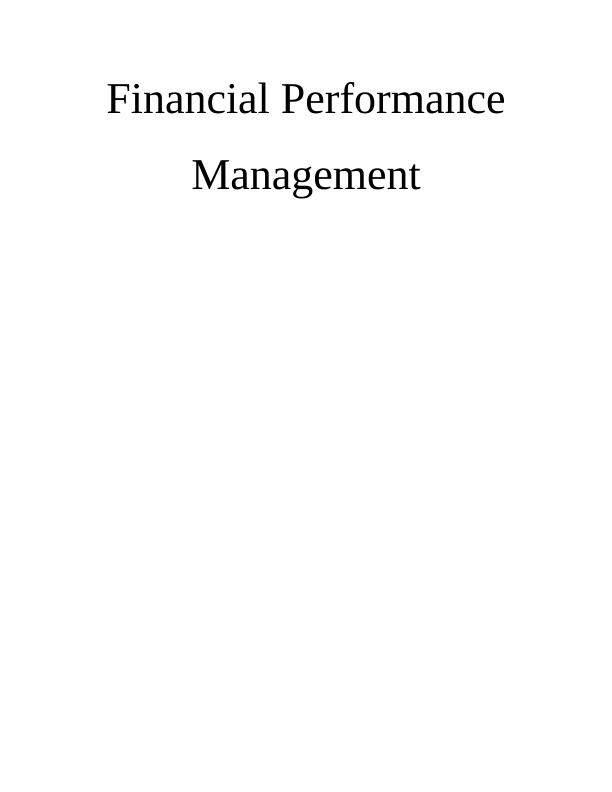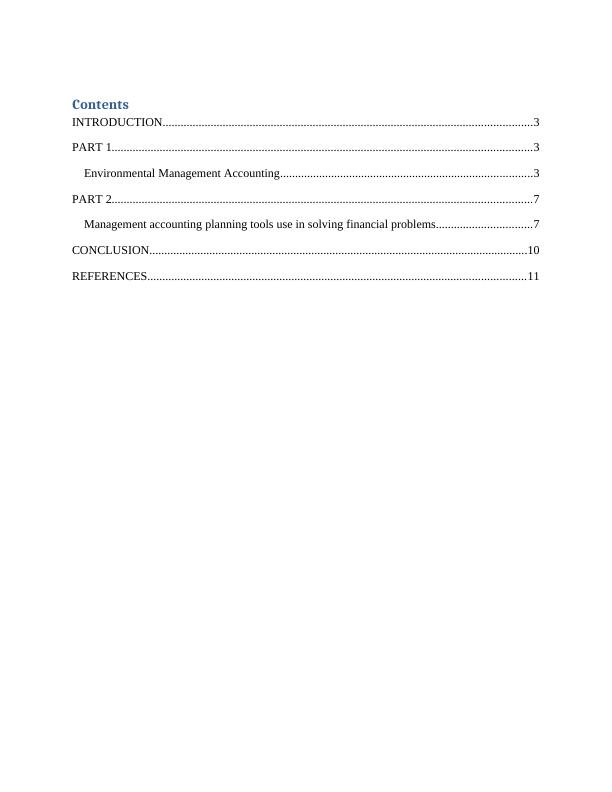Financial Performance Management
Added on 2023-01-04
11 Pages3661 Words52 Views
Financial Performance
Management
Management

Contents
INTRODUCTION...........................................................................................................................3
PART 1............................................................................................................................................3
Environmental Management Accounting....................................................................................3
PART 2............................................................................................................................................7
Management accounting planning tools use in solving financial problems................................7
CONCLUSION..............................................................................................................................10
REFERENCES..............................................................................................................................11
INTRODUCTION...........................................................................................................................3
PART 1............................................................................................................................................3
Environmental Management Accounting....................................................................................3
PART 2............................................................................................................................................7
Management accounting planning tools use in solving financial problems................................7
CONCLUSION..............................................................................................................................10
REFERENCES..............................................................................................................................11

INTRODUCTION
The systematic method of keeping process allows of each and almost every financial exchange
so that careful review can take place to decide the field of adjustment is known as analysis of
business results. An environment protection tool is a structure and database that integrates
strategies and procedures for training personnel, monitoring, summarising and sharing detailed
environmental reporting input from key individuals in the enterprise (Churet and Eccles, 2014).
In the ideal world, businesses will reflect the consequences of sustainability in their financial
statements by identifying the environmental impacts applied to products, operations and services.
This study is split into two sections; the part 1 covers challenges encountered by companies in
controlling its Environmental impacts and the various approaches used by companies in
reporting of its Environmental Expenses. In addition, budgetary control preparation techniques
are used to address financial issues that may impact the financial results and to obtain financial
capital.
PART 1
Environmental Management Accounting
Environmental Management Accounting (EMA) is also an effort to merge the thinking and
experience of highest quality practices with good environmental conservation thinking and
practise (Kroes and Manikas, 2014). In which a corporation's financial performance is measured
by the sustainability of economical and operational metrics using different approaches, such as
reporting and auditing, which are applicable to some companies, but where economic plans are
taken up with respect to environmental, like maximum financial reporting, cost estimation,
benefit assessment and some good planning. EMA discusses administrators' management
knowledge requirements for business operations that damage the environment, and also the
environmental effects on the organisation. Environmental effects could involve effluent output,
disposal, water and power use and carbon emissions, based on the form of entity.
Information from management may include:
Classifying and calculating the costs of operations associated with the ecosystem
Recognizing and recording the usage and expense of services such as water, energy and
fuel to minimise costs
The systematic method of keeping process allows of each and almost every financial exchange
so that careful review can take place to decide the field of adjustment is known as analysis of
business results. An environment protection tool is a structure and database that integrates
strategies and procedures for training personnel, monitoring, summarising and sharing detailed
environmental reporting input from key individuals in the enterprise (Churet and Eccles, 2014).
In the ideal world, businesses will reflect the consequences of sustainability in their financial
statements by identifying the environmental impacts applied to products, operations and services.
This study is split into two sections; the part 1 covers challenges encountered by companies in
controlling its Environmental impacts and the various approaches used by companies in
reporting of its Environmental Expenses. In addition, budgetary control preparation techniques
are used to address financial issues that may impact the financial results and to obtain financial
capital.
PART 1
Environmental Management Accounting
Environmental Management Accounting (EMA) is also an effort to merge the thinking and
experience of highest quality practices with good environmental conservation thinking and
practise (Kroes and Manikas, 2014). In which a corporation's financial performance is measured
by the sustainability of economical and operational metrics using different approaches, such as
reporting and auditing, which are applicable to some companies, but where economic plans are
taken up with respect to environmental, like maximum financial reporting, cost estimation,
benefit assessment and some good planning. EMA discusses administrators' management
knowledge requirements for business operations that damage the environment, and also the
environmental effects on the organisation. Environmental effects could involve effluent output,
disposal, water and power use and carbon emissions, based on the form of entity.
Information from management may include:
Classifying and calculating the costs of operations associated with the ecosystem
Recognizing and recording the usage and expense of services such as water, energy and
fuel to minimise costs

Make sure that environmental issues are part of judgments on capital investment
Evaluating the probability and effect of environmental threats
Including environmental metrics as part of the regular evaluation of results
Activities for measuring toward best practise in the environment.
Importance:
Improving revenue or reducing sales erosion: Buyer understanding of the environmental
effect of goods and services is gradually impacting their tastes and purchase habits.
Cost savings: reducing unnecessary production capital use has a clear positive effect on
cost reduction. Method upgrades will also bite down on prices (Alshatti, 2015).
Reducing failure costs: engaging in systems that minimise the risk and expense effects of
failure, as well as the need to manage wastes or clean it up the influences of the
environment.
Boost the organization's image: this will allow it to recruit good skills, reduce the
turnover of talent and increase prices.
Environmental costs
Material Production Material Cost:
The first step in the assessment and procurement of suppliers was preventative practises. Another
one of the other steps is to estimate and install equipment for pollution control. Deciding or using
recyclable plastic in the well-organized and ordered way will profit and environmental
assessment monitoring would all contribute to environmental sustainable development.
NPO's Materials:
Detection exercises review the manufacturing practises, as well as identification of the individual
delivering environmental results.
Cost of Waste and Pollution Control:
Careful testing of the polluted air systems requires internal fault activities. Taking care of the
pollution job machinery and maintaining the tattered goods.
Less Cost Measurable:
External failure practises include making sure that the waterways and lakes are protected. The
world doesn't affect it. Unacceptable utilisation of sources and services also exacerbates this
Evaluating the probability and effect of environmental threats
Including environmental metrics as part of the regular evaluation of results
Activities for measuring toward best practise in the environment.
Importance:
Improving revenue or reducing sales erosion: Buyer understanding of the environmental
effect of goods and services is gradually impacting their tastes and purchase habits.
Cost savings: reducing unnecessary production capital use has a clear positive effect on
cost reduction. Method upgrades will also bite down on prices (Alshatti, 2015).
Reducing failure costs: engaging in systems that minimise the risk and expense effects of
failure, as well as the need to manage wastes or clean it up the influences of the
environment.
Boost the organization's image: this will allow it to recruit good skills, reduce the
turnover of talent and increase prices.
Environmental costs
Material Production Material Cost:
The first step in the assessment and procurement of suppliers was preventative practises. Another
one of the other steps is to estimate and install equipment for pollution control. Deciding or using
recyclable plastic in the well-organized and ordered way will profit and environmental
assessment monitoring would all contribute to environmental sustainable development.
NPO's Materials:
Detection exercises review the manufacturing practises, as well as identification of the individual
delivering environmental results.
Cost of Waste and Pollution Control:
Careful testing of the polluted air systems requires internal fault activities. Taking care of the
pollution job machinery and maintaining the tattered goods.
Less Cost Measurable:
External failure practises include making sure that the waterways and lakes are protected. The
world doesn't affect it. Unacceptable utilisation of sources and services also exacerbates this

End of preview
Want to access all the pages? Upload your documents or become a member.
Related Documents
Financial Performance Managementlg...
|12
|3828
|25
Environmental Accountability and Management Accounting for Financial Performancelg...
|11
|3528
|33
Financial Performance Management: Environmental Management Accounting and Management Accounting Planning Toolslg...
|10
|3415
|84
Environmental Management Accounting and its Importance in Financial Performancelg...
|11
|3381
|82
Importance of Environmental Accounting and Management of Environmental Costs for Organizationslg...
|13
|3858
|59
Financial Performance Managementlg...
|15
|4444
|100
